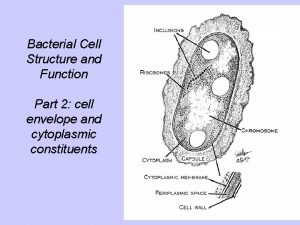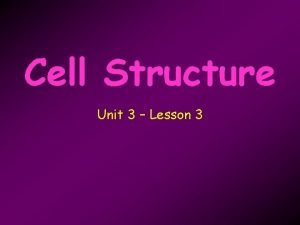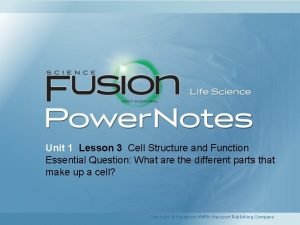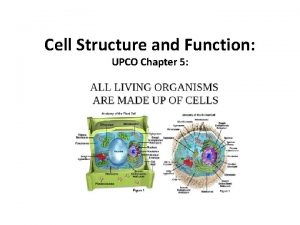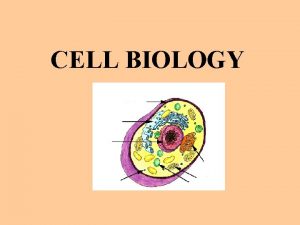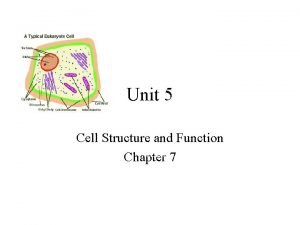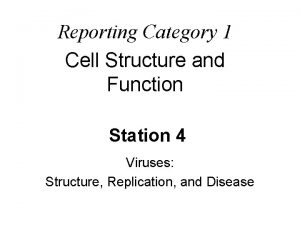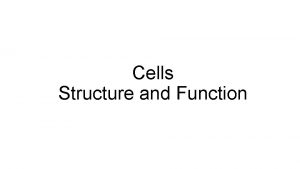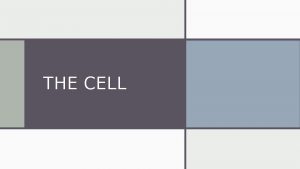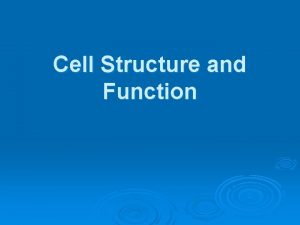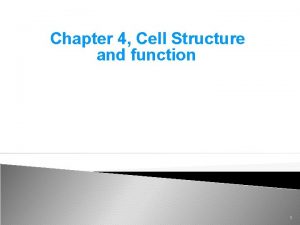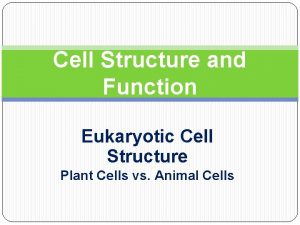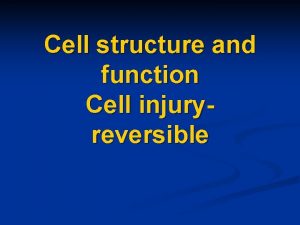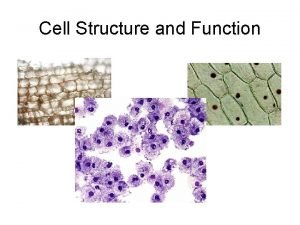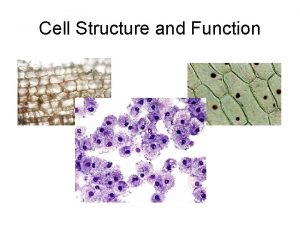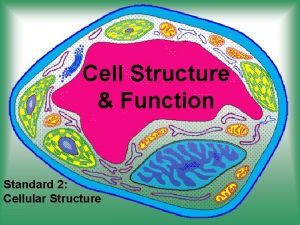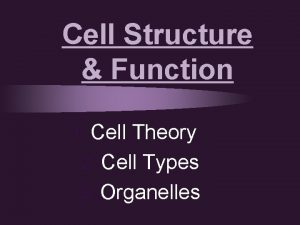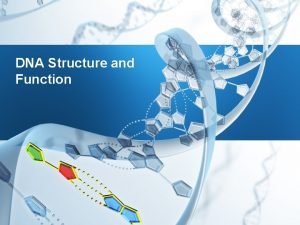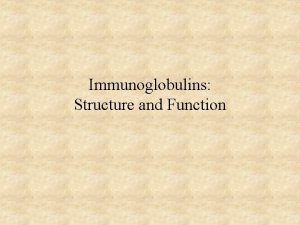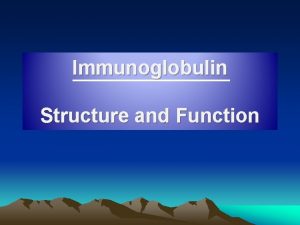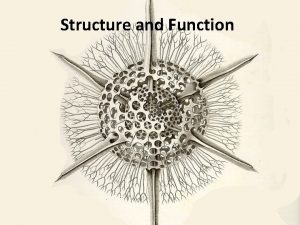Cell Structure and Function What the cell is




























































- Slides: 60

Cell Structure and Function What the cell is going on here?

What the cell is happening?

CELL BIOLOGY All living things are made up of small individual units called cells. Cells are the smallest functioning living unit. Cells can not normally be seen with the naked eye. To usually observe a cell, you need a microscope! I will list the parts of the cell theory and compare and contrast prokaryotes and eukaryotes.

Robert Hooke and Anton van Leeuwenhoek used the first 'primitive' microscopes to observe stuff in the mid 1600's! In the 400+ years since, improvements in the microscope have allowed scientists to observe cells better and to develop the cell theory.

The Cell Theory 1. All organisms are made up of one or more cells (unicellular or multicellular). 2. All cells carry out the 7 life functions. 3. All cells come from preexisting cells. BUT. . . I will list the parts of the cell theory and compare and contrast prokaryotes and eukaryotes.

Exceptions to Cell Theory A. B. C. Where did the first cells come from? CHICKEN AND THE EGG SYNDROME Viruses are NOT composed of cells. But they do contain genetic material (DNA and/or RNA). They also can reproduce in the presence of a host cell. Some cell parts (mitochondria and chloroplast) contain their own genetic material (DNA and/or RNA) and can reproduce in a cell. I will list the parts of the cell theory and compare and contrast prokaryotes and eukaryotes.

Remember: 3 PARTS TO THE CELL THEORY & 3 EXCEPTIONS TO THE CELL THEORY I will list the parts of the cell theory and compare and contrast prokaryotes and eukaryotes.

a great way to see how big different things are; good metric review http: //www. cellsalive. com/howbig. htm I will list the parts of the cell theory and compare and contrast I will describe how life is organized. prokaryotes and eukaryotes.

How Life is Organized. . . I will list the parts of the cell theory and compare and contrast I will describe how life is organized. prokaryotes and eukaryotes.

Atoms and Molecules the building blocks of everything in the universe I will list the parts of the cell theory and compare and contrast I will describe how life is organized. prokaryotes and eukaryotes.

Organelles small parts of cells that have specific functions different organelles have different jobs

Cells the building blocks of life all living things are made up of one (unicellular) or more (multicellular) cells there are many types ex. muscle cells, neurons (brain cells), skin cells, bone cells, blood cells I will list the parts of the cell theory and compare and contrast I will describe how life is organized. prokaryotes and eukaryotes.

Tissue a group of cells that perform a certain function ex. muscles, tendons, nerves I will list the parts of the cell theory and compare and contrast I will describe how life is organized. prokaryotes and eukaryotes.

Organs § a group of tissues that perform a certain function § like organelles, different organs carry out different functions § ex. brain, heart, skin, liver, intestines I will list the parts of the cell theory and compare and contrast I will describe how life is organized. prokaryotes and eukaryotes.

Organ Systems § § a group of organs that perform a certain function organ systems have specific jobs § ex. digestive system, circulatory system, nervous system, reproductive system I will list the parts of the cell theory and compare and contrast I will describe how life is organized. prokaryotes and eukaryotes.

Organism a thing that carries out the 7 life functions Organization Use Energy Grow Evolve Reproduce Respond Interdependance

Population a group of organisms of the same species in a given area I will list the parts of the cell theory and compare and contrast I will describe how life is organized. prokaryotes and eukaryotes.

Community a group of populations in a given area I will list the parts of the cell theory and compare and contrast I will describe how life is organized. prokaryotes and eukaryotes.

Ecosystem a community and the physical non-living environment that it exists in

Biosphere the region of earth where life exists all ecosystems on the planet make up the biosphere I will list the parts of the cell theory and compare and contrast I will describe how life is organized. prokaryotes and eukaryotes.


Prokaryotes and Eukaryotes As microscopes improved over the years, scientists were able to see into cells with more detail. There were able to see that there are two main types of cells. . . PROKARYOTES and EUKARYOTES I will list the parts of the cell theory and compare and contrast prokaryotes and eukaryotes.


Prokaryotes lack any internal membranes only the kingdoms bacteria and archaebacteria are prokaryotes I will list the parts of the cell theory and compare and contrast prokaryotes and eukaryotes.

Eukaryotes have many internal membrane structures: nucleus-contains genetic material other organelles ('small organs')

Both Prokaryotes and Eukaryotes are Basically Alike both have outer membranes both carry out the 7 life functions

Prokaryote Eukaryote Unicellular Multicellular Archaebacteria Bacteria Protist Fungi Plant Animal I will list the parts of the cell theory and compare and contrast prokaryotes and eukaryotes.

Comparing Prokaryotes and Eukaryotes Prokaryotes Cell Membrane Contain DNA Eukaryotes Nucleus Endoplasmic Reticulum Golgi Body Vacuoles Lysosome Mitochondria Cytoskeleton

Different Cell Parts Do Different Jobs In cells, various specialized functions occur in specific places. These places are like small organs to the cell. They are called organelles! They’re like mini-organs! I will describe the function of each organelle and explain how it contributes to cellular processes.

Different Cell Parts Do Different Jobs Organelles allow the cell to do 3 main jobs make energy need energy for all activities need to clean up waste produced while making energy make proteins do all the work in a cell, so we need lots of them make Our organelles do all these jobs! more cells for growth to replace damaged or diseased cells I will describe the function of each organelle and explain how it contributes to cellular processes.

1. Cells Need Power! Making energy to fuel daily life & growth, the cell must… take in food & digest it take in oxygen (O 2) make ATP remove waste organelles that do this work… cell membrane lysosomes vacuoles & vesicles mitochondria chloroplast (plant cells only) I will describe the function of each organelle and explain how it contributes to cellular processes.

Cell Membrane Function separates cell from outside controls what enters or leaves cell O 2, CO 2, food, H 2 O, nutrients, waste recognizes signals from other cells allows communication between cells I will describe the function of each organelle and explain how it contributes to cellular processes.

Cell Membrane phosphate “head” Structure double layer of fat phospholipid bilayer receptor lipid “tail” molecules proteins sea” “protein ice bergs floating in a fatty


http: //www. youtube. com/watch? v=Qqsf_UJcf. Bc

Lysosomes Function digest food used to make energy clean up & recycle digest broken organelles Structure membrane sac of digestive enzymes

http: //www. youtube. com/watch? v=ekd. IEp. Sf-1 I

Vacuoles & Vesicles Function moving material around Structure membrane sac cell storage – plants store more, so they have larger vacuoles. I will describe the function of each organelle and explain how it contributes to cellular processes.

Mitochondria Function ATP make ATP energy from cellular respiration sugar + O 2 ATP fuels the work of life Structure double membrane I will describe the function of each organelle and explain how it contributes to cellular processes.

Plants make Energy Two Ways! Mitochondria Chloroplasts make ATP energy + sugar from sunlight photosynthesis sunlight + CO 2 ATP & sugar ATP = active energy sugar = stored energy build leaves & roots & fruit out of the sugars I will describe the function of each organelle and explain how it contributes to cellular processes. sugar ATP

2. Cells Need Workers to Make Proteins! Making proteins to run daily life & growth, the cell must… read genes (DNA) build proteins structural proteins (muscle fibers, hair, skin, claws) enzymes (speed up chemical reactions) signals (hormones) & receptors organelles that do this work… nucleus ribosomes endoplasmic reticulum (ER) golgi apparatus

Proteins Do All The Work! one of the major job of cells is to make proteins, because… proteins do all the work! structural enzymes signals receptors DNA proteins cells

Nucleus Function control center of cell protects DNA instructions for building proteins Structure nuclear membrane nucleolus ribosome factory chromosomes DNA I will describe the function of each organelle and explain how it contributes to cellular processes.

http: //www. youtube. com/watch? v=Fxtrp 6 LMVCc

Ribosomes Function protein factories read instructions to build proteins from DNA Structure some free in cytoplasm some attached to ER I will describe the function of each organelle and explain how it contributes to cellular processes.

Endoplasmic Reticulum Function works on proteins helps complete the proteins after ribosome builds them makes membranes Structure rough ER ribosomes attached works on proteins smooth ER makes membranes

Golgi Apparatus Function finishes, sorts, labels & ships proteins like UPS headquarters shipping & receiving department ships proteins in vesicles “UPS trucks” Structure membrane vesicles carrying proteins sacs transport vesicles

endoplasmic reticulum nucleus protein on its way! DNA RNA vesicle TO: vesicle ribosomes TO: protein Making Proteins finished protein Golgi apparatus

3. Cells Need to Make More Cells! Making more cells to replace, repair & grow, the cell must… copy their DNA make extra organelles divide the new DNA & new organelles between 2 new “daughter” cells organelles that do this work… nucleus centrioles I will describe the function of each organelle and explain how it contributes to cellular processes.

Centrioles Function help coordinate cell division only in animal cells Structure one pair in each cell I will describe the function of each organelle and explain how it contributes to cellular processes.


http: //www. youtube. com/watch? v=o 3 x. R 1 Fw 0 B 6 w I will describe the function of each organelle and explain how it contributes to cellular processes.

cytoplasm jelly-like material holding organelles in place vacuole & vesicles transport inside cells storage lysosome food digestion garbage disposal & recycling nucleus protects DNA controls cell centrioles cell division ribosomes builds proteins mitochondria make ATP energy from sugar + O 2 cell membrane cell boundary controls movement of materials in & out recognizes signals ER helps finish proteins makes membranes Golgi apparatus finishes, packages & ships proteins

nucleus control cell protects DNA nucleolus make ribosomes endoplasmic reticulum processes proteins makes membranes ribosomes make proteins cytoplasm jelly-like material around organelles central vacuole storage: food, water or waste Golgi apparatus finish & ship proteins cell wall support mitochondria make ATP in cellular respiration cell membrane cell boundary controls movement of materials in & out recognizes signals chloroplast make ATP & sugars in photosynthesis lysosome digestion & clean up

Cell Summary Cells have 3 main jobs make energy make proteins make more cells I will describe the function of each organelle and explain how it contributes to cellular processes.

Comparing Plant and Animal Cells Plant Cell Wall Chloroplasts Animal Cell Nucleus Cell Membrane Endoplasmic Reticulum Ribosomes Lysosome Mitochondria Vacuoles Golgi Body Centrioles Cytoskeleton I will describe the function of each organelle and explain how it contributes to cellular processes.

The Cell as a Football Team http: //prezi. com/t 9 qggkbxeifh/co py-of-cell-analogy-football-team/ I will describe the function of each organelle and explain how it contributes to cellular processes.

Viruses I will describe the function of each organelle and explain how it contributes to cellular processes.

Viruses are not cells! viruses can NOT carry out most life functions, however. . . they can REPRODUCE reproduction of viruses can only happen inside a host cell! viruses, along with bacteria (cells), fungi (cells), and other parasites can infect plants and animals and interfere with normal life functions! ex. influenza, HIV, chicken pox, polio, smallpox (gone!), viral pneumonia

 Bacterial cell structure and function
Bacterial cell structure and function Lesson 3 cell structure and function answer key
Lesson 3 cell structure and function answer key Cell structures cell organelle graphic organizer
Cell structures cell organelle graphic organizer Vacuole function
Vacuole function What cell is this
What cell is this Biology chapter 7 cell structure and function
Biology chapter 7 cell structure and function Chapter 7 cell structure and function section review 7-2
Chapter 7 cell structure and function section review 7-2 Cell structure and function graphic organizer
Cell structure and function graphic organizer Chapter 5 cell structure and function
Chapter 5 cell structure and function Plastids in plant cell
Plastids in plant cell Unit 5 cell structure and function answer key
Unit 5 cell structure and function answer key Category 1 cell structure and function
Category 1 cell structure and function Category 1 cell structure and function
Category 1 cell structure and function Category 1: cell structure and function
Category 1: cell structure and function Middle lamella
Middle lamella Hình ảnh bộ gõ cơ thể búng tay
Hình ảnh bộ gõ cơ thể búng tay Bổ thể
Bổ thể Tỉ lệ cơ thể trẻ em
Tỉ lệ cơ thể trẻ em Voi kéo gỗ như thế nào
Voi kéo gỗ như thế nào Thang điểm glasgow
Thang điểm glasgow Chúa yêu trần thế alleluia
Chúa yêu trần thế alleluia Môn thể thao bắt đầu bằng từ đua
Môn thể thao bắt đầu bằng từ đua Thế nào là hệ số cao nhất
Thế nào là hệ số cao nhất Các châu lục và đại dương trên thế giới
Các châu lục và đại dương trên thế giới Công thức tính thế năng
Công thức tính thế năng Trời xanh đây là của chúng ta thể thơ
Trời xanh đây là của chúng ta thể thơ Mật thư tọa độ 5x5
Mật thư tọa độ 5x5 Phép trừ bù
Phép trừ bù Phản ứng thế ankan
Phản ứng thế ankan Các châu lục và đại dương trên thế giới
Các châu lục và đại dương trên thế giới Thể thơ truyền thống
Thể thơ truyền thống Quá trình desamine hóa có thể tạo ra
Quá trình desamine hóa có thể tạo ra Một số thể thơ truyền thống
Một số thể thơ truyền thống Cái miệng bé xinh thế chỉ nói điều hay thôi
Cái miệng bé xinh thế chỉ nói điều hay thôi Vẽ hình chiếu vuông góc của vật thể sau
Vẽ hình chiếu vuông góc của vật thể sau Nguyên nhân của sự mỏi cơ sinh 8
Nguyên nhân của sự mỏi cơ sinh 8 đặc điểm cơ thể của người tối cổ
đặc điểm cơ thể của người tối cổ Giọng cùng tên là
Giọng cùng tên là Vẽ hình chiếu đứng bằng cạnh của vật thể
Vẽ hình chiếu đứng bằng cạnh của vật thể Fecboak
Fecboak Thẻ vin
Thẻ vin đại từ thay thế
đại từ thay thế điện thế nghỉ
điện thế nghỉ Tư thế ngồi viết
Tư thế ngồi viết Diễn thế sinh thái là
Diễn thế sinh thái là Các loại đột biến cấu trúc nhiễm sắc thể
Các loại đột biến cấu trúc nhiễm sắc thể Số.nguyên tố
Số.nguyên tố Tư thế ngồi viết
Tư thế ngồi viết Lời thề hippocrates
Lời thề hippocrates Thiếu nhi thế giới liên hoan
Thiếu nhi thế giới liên hoan ưu thế lai là gì
ưu thế lai là gì Khi nào hổ con có thể sống độc lập
Khi nào hổ con có thể sống độc lập Sự nuôi và dạy con của hươu
Sự nuôi và dạy con của hươu Sơ đồ cơ thể người
Sơ đồ cơ thể người Từ ngữ thể hiện lòng nhân hậu
Từ ngữ thể hiện lòng nhân hậu Thế nào là mạng điện lắp đặt kiểu nổi
Thế nào là mạng điện lắp đặt kiểu nổi Structure and function of community and school in pakistan
Structure and function of community and school in pakistan Advantages and disadvantages of diaphragm cell process
Advantages and disadvantages of diaphragm cell process Prokaryotic cell and eukaryotic cell similarities
Prokaryotic cell and eukaryotic cell similarities Animal cell plant cell venn diagram
Animal cell plant cell venn diagram
